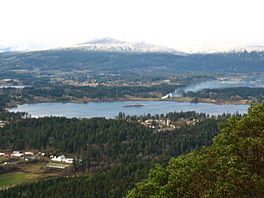Quamichan Lake facts for kids
Quick facts for kids Quamichan LakeKwamutsun Xatsa' |
|
|---|---|

Aerial view of Quamichan Lake
|
|
| Location | North Cowichan, Vancouver Island |
| Coordinates | 48°48′05″N 123°39′38″W / 48.80139°N 123.66056°W |
| Type | Monomictic lake |
| Part of | Cowichan watershed |
| Primary inflows | McIntyre Creek |
| Primary outflows | Quamichan Creek |
| Basin countries | Canada |
| Surface area | 313.4 ha (774 acres) |
| Average depth | 4.7 m (15 ft) |
| Max. depth | 8.2 m (27 ft) |
| Shore length1 | 8,348 m (27,388 ft) |
| Surface elevation | 26 m (85 ft) |
| Islands | Rainbow Island |
| 1 Shore length is not a well-defined measure. | |
Quamichan Lake is a beautiful lake located on Vancouver Island in British Columbia, Canada. It's part of the Cowichan Valley region. You can find it about three kilometres northeast of the city of Duncan.
This lake, along with its nearby partner Somenos Lake, was formed around 11,000 years ago. This happened when huge glaciers melted and moved away. Both lakes play a role in the Cowichan River system. Water flows out of Quamichan Lake through Quamichan Creek. This creek then joins Somenos Creek, which comes from Somenos Lake, and together they flow into the Cowichan River.
Contents
What's Happening with the Lake?
Experts who study the Cowichan Watershed have noticed some challenges for Quamichan Lake. These challenges are similar to those faced by Somenos Lake.
- Too many nutrients: Farms and homes around the lake can add extra nutrients. These nutrients act like fertilizer for plants in the water.
- Not enough fresh water: In summer, less water flows into the lake. Also, less water flows out. This means the lake isn't "flushed" out as well as it should be.
- Lots of plant growth: With extra nutrients and less flushing, plants like algae can grow very quickly. This is often called an "algae bloom."
- Low oxygen levels: When these plants die, they break down. This process uses up a lot of oxygen in the water. Low oxygen can be harmful to fish and other lake creatures.
- Getting warmer: The lake's water temperature has been increasing.
In the autumn of 2016, there was a lot of news about the lake's algae. Sadly, it was reported that the algae caused harm to at least four dogs.
Where Did the Name Come From?
The name "Quamichan" comes from the lore of the Cowichan Tribes. In their stories, there was an ogress named Quamichan. An ogress is a giant, scary female creature. This ogress was said to steal and eat children.
A group of the Cowichan people, called Kw'amutsun, adopted this name. Their community was located right next to the lake.
Lake Habitat and Wildlife
Quamichan Lake covers a large area of 313.4 hectares (about 774 acres). It's a shallow lake, with an average depth of 4.7 meters (about 15 feet). The deepest part of the lake is 8.2 meters (about 27 feet). The land around the lake that drains into it is 16.3 square kilometres.
Near the lake, you can find the Cowichan Garry Oak Preserve. This is a special area that protects Garry Oak trees.
The lake is home to different kinds of life.
- Plants: You'll find algae growing in the water.
- Fish: The lake has trout, as well as Pumpkinseed fish and catfish. Pumpkinseed fish are an invasive species, meaning they are not native to the area and can sometimes cause problems for local wildlife.
- Birds: Many migratory birds come to Quamichan Lake in the winter. The lake rarely freezes over, making it a good spot for them.
Protecting the Lake
In 2007, a group called the Quamichan Watershed Stewardship Society was formed. People living and farming around the lake started this group. They were worried about the lake's health and wanted to help improve it.
Between 2010 and 2014, about 65,500 trout were added to the lake. These fish came from a hatchery. In 2014, a special project helped create a "trout refuge." This refuge included a system that blows bubbles into the water. This "bubble aeration system" helps to add oxygen to the water. It's especially important in late summer when algae die and use up a lot of oxygen.
Many groups worked together on this project. These included the Municipality of North Cowichan, the Rotary Club of Duncan, and the Quamichan Watershed Stewardship Society.
Living by the Lake
Art Mann Park Beach is a public park located by the lake. It has play areas for kids and a place where people can launch their boats.
Some of the homes around Quamichan Lake are among the most expensive on Vancouver Island, especially north of Victoria. The famous singer Will Millar from the band The Irish Rovers lives near the lake.


